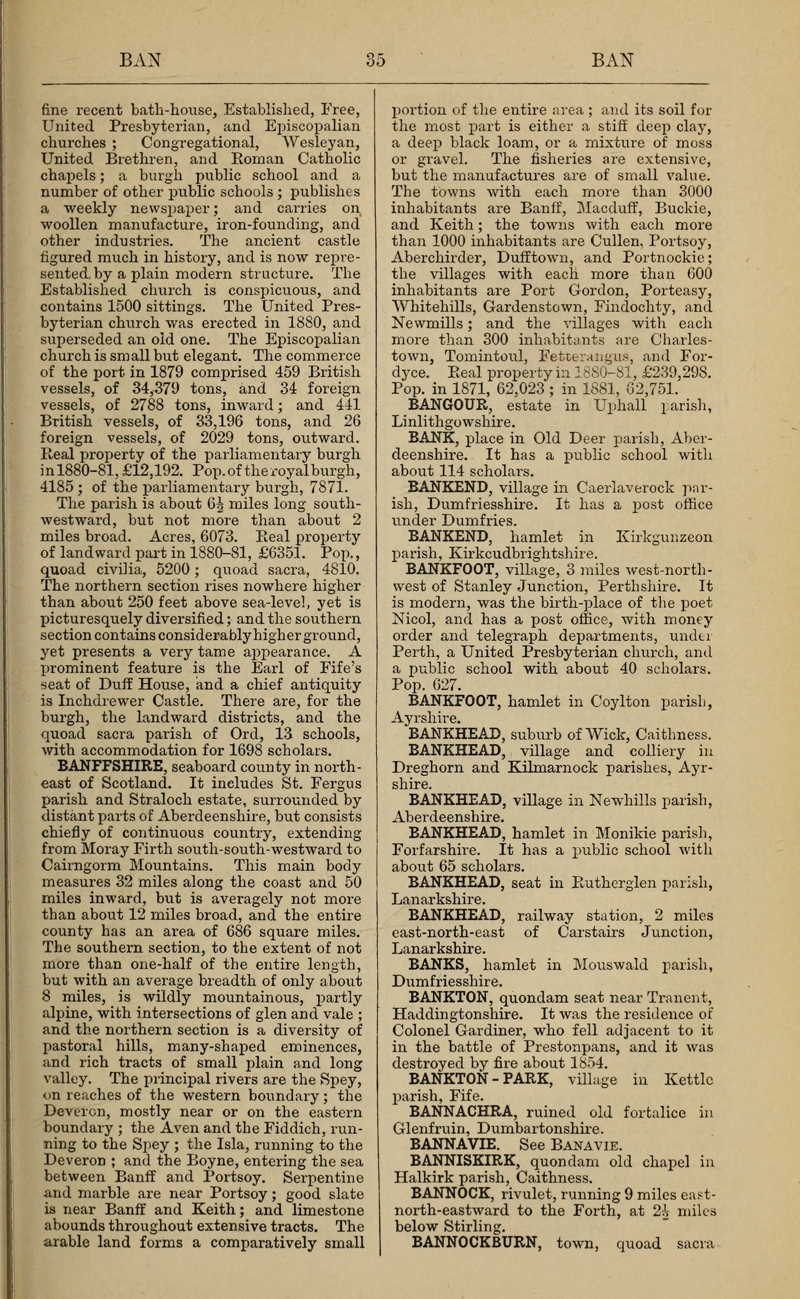BANFFSHIRE, seaboard county in north-east of Scotland. It includes St. Fergus parish and Straloch estate, surrounded by distant parts of Aberdeenshire, but consists chiefly of continuous country, extending from Moray Firth south-south-westward to Cairngorm Mountains. This main body measures 32 miles along the coast and 50 miles inward, but is averagely not more than about 12 miles broad, and the entire county has an area of 686 square miles. The southern section, to the extent of not more than one-half of the entire length, but with an average breadth of only about 8 miles, is wildly mountainous, partly alpine, with intersections of glen and vale ; and the northern section is a diversity of pastoral hills, many-shaped eminences, and rich tracts of small plain and long valley. The principal rivers are the Spey, on reaches of the western boundary ; the Devercn, mostly near or on the eastern boundary ; the Aven and the Fiddich, running to the Spey ; the Isla, running to the Deveron ; and the Boyne, entering the sea between Banff and Portsoy. Serpentine and marble are near Portsoy ; good slate is near Banff and Keith; and limestone abounds throughout extensive tracts. The arable land forms a comparatively small portion of the entire area ; and its soil for the most part is either a stiff deep clay, a deep black loam, or a mixture of moss or gravel. The fisheries are extensive, but the manufactures are of small value. The towns with each more than 3000 inhabitants are Banff, Macduff, Buckie, and Keith ; the towns with each more than 1000 inhabitants are Cullen, Portsoy, Aberchirder, Dufftown, and Portnockie; the villages with each more than 600 inhabitants are Port Gordon, Porteasy, Whitehills, Gardenstown, Findochty, and Newmills ; and the villages with each more than 300 inhabitants are Charlestown, Tomintoul, Fetteraiigus, and Fordyce. Real property in 1680-81, 239,298. Pop. in 1871, 62,023 ; in 1881, 62,751.
BANGOUR, estate in Uphall jarish, Linlithgowshire.
BANK, place in Old Deer parish, Aberdeenshire. It has a public school with about 114 scholars.
BANKEND, village in Caerlaverock parish, Dumfriesshire. It has a post office under Dumfries.
BANKEND, hamlet in Kirkgunzeon parish, Kirkcudbrightshire.
BANKFOOT, village, 3 miles west-north-west of Stanley Junction, Perthshire. It is modern, was the birth-place of the poet Nicol, and has a post office, with money order and telegraph departments, under Perth, a United Presbyterian church, and a public school with about 40 scholars. Pop. 627.
BANKFOOT, hamlet in Coylton parish, Ayrshire.
BANKHEAD, suburb of Wick, Caithness.
BANKHEAD, village and colliery in Dreghorn and Kilmarnock parishes, Ayrshire.
BANKHEAD, village in Newhills parish, Aberdeenshire.
BANKHEAD, hamlet in Monikie parish, Forfarshire. It has a public school with about 65 scholars.
BANKHEAD, seat in Rutherglen parish, Lanarkshire.
BANKHEAD, railway station, 2 miles east-north-east of Carstairs Junction, Lanarkshire.
BANKS, hamlet in Mouswald parish, Dumfriesshire.
BANKTON, quondam seat near Tranent, Haddingtonshire. It was the residence of Colonel Gardiner, who fell adjacent to it in the battle of Prestonpans, and it was destroyed by fire about 1S54.
BANKTON - PARK, village in Kettle parish, Fife.
BANNACHRA, ruined old fortalice in Glenfruin, Dumbartonshire.
BANNA VIE.
BANNISKIRK, quondam old chapel in Halkirk parish, Caithness.
BANNOCK, rivulet, running 9 miles east-north-eastward to the Forth, at 2r> miles below Stirling.
BANNOCKBURN, town, quoad sacra parish, and battle-field, in St. Ninians parish, Stirlingshire. The town stands on Bannock rivulet, 2f miles south-south-east of Stirling, is a seat of flourishing woollen manufacture, and has a post office, with money order and telegraph departments, under Stirling, a railway station, Established, Free, and United Presbyterian churches, and a public school with about 323 scholars. Pop. of the town, 2549 ; of the quoad sacra parish, 3281. The battle-field, the scene of Bruce's famous victory in 1314, lies on Bannock rivulet, adjacent to the south end of St. Ninians town, and retains, under an iron grating, with surmounting flag-staff, fragments of the large block of stone in which Bruce planted his standard.

